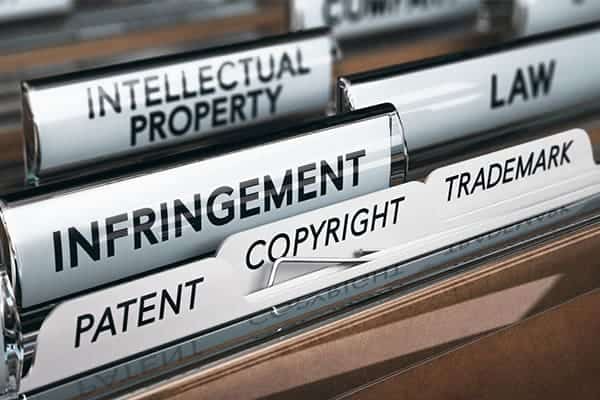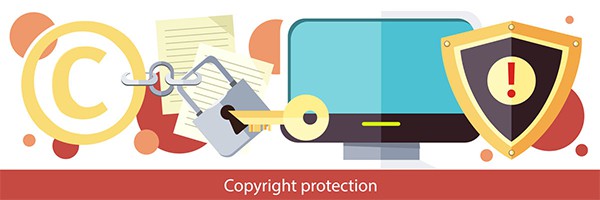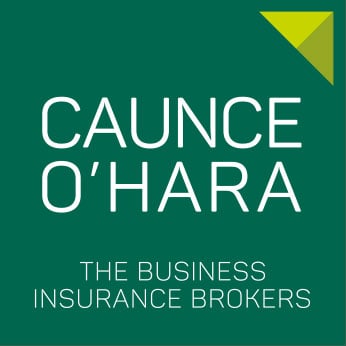
Trade Marks: Everything you need to know from registration to infringement
Posted on 22nd June 2021 by Katherine Ducie

Trade marks are a type of intellectual property that many businesses have. In its simplest form, intellectual property is ‘a collection of ideas and information in a broadly commercial context that the law recognises as having a value and is therefore deserving of protection’. (1)
For many businesses who have a logo and brand to consider, understanding what a trade mark is and how to protect your business is important.
Without sufficiently understanding how trade marks and copyright works, you could unintentionally end up breaking the law which could leave your company facing court proceedings or a substantial fine.
In this article, we’ll explain exactly what a trade mark covers, how to register a trade mark, the difference between copyright and trade mark registration and trade mark infringement. It will also touch upon the law of passing off, which is closely linked to the law surrounding trade marks and copyright.
What is a trade mark?
A trade mark is a mark, brand or sign used by traders to differentiate their goods from those of other traders. Trade marks need to be formally registered with the Intellectual Property Office. If your brand name or logo is not formally registered, then trade mark law will not help you. Instead you will be left relying on the law of copyright and/or passing off, which are discussed later in this article.
Under the Trade Marks Act 1994, any sign which can be represented graphically and which is capable of distinguishing the goods or services of one business from those of another, is registrable as a trade mark (subject to the absolute and relative grounds for refusal).
Examples of trade marks include labels, words, logos, names (including domain names), packaging, smells and sounds. Although you can trade mark a name, trade mark goes beyond the name of a product or its logo and can also cover the colour and shape of goods.
Examples of this include a Marmite jar or a Coca Cola bottle, both of which are distinctly recognisable for each brand.
Trade mark registration
To obtain a registered trade mark, you must apply for registration through the Intellectual Property Office (IPO), for which a fee is charged.
The Intellectual Property Office (IPO) is the official government body accountable for intellectual property (IP) rights such as patents, designs, trade marks and copyright in the UK.
You can find out more about the cost of registration on the GOV.UK trademark forms and fees page. Every 10 years, your trade mark will need to be renewed. You can renew a trade mark in the 6 months before it expires and up to 6 months afterwards.
If you would prefer a wider scope on protection outside of the UK, it’s worth looking into an application for a European trade mark or alternatively, an International trade mark.
What is the difference between copyright and trade mark registration?
Copyright protects your work and prevents others from using it or copying it without your consent.
Copyright protection is automatic and free. Unlike trade mark registration, there is not a register of copyright works in the UK.
Copyright applies automatically to the creation of:
- “original literary, dramatic, musical and artistic work, including illustration and photography
- original non-literary written work, such as software, web content and databases
- sound and music recordings
- film and television recordings
- broadcasts
- the layout of published editions of written, dramatic and musical works” [12].
A business logo for example will be protected by copyright, as it is considered original artistic work.
The length for which copyright applies depends on the type of work. The shortest duration for copyright applying is 25 years for the layout of published editions of written, dramatics and musical works.
For written, dramatic, musical and artistic work, copyright lasts 70 years after the author’s death. Copyright determines the rights people have over the original work they create. Copyright can be sold or assigned to other parties and typically work created by employees is owned by the business.
Trade mark registration on the other hand, as mentioned above, generally protects the brand or organisation who registered it, rather than the original artist.
Unlike copyright which is free and automatic, you must register and pay for trade mark registration.

Passing Off
Passing off is the area of law that protects the reputation and goodwill of a business and prevents people from selling goods under the pretence that they are the goods of another. It serves to protect the trader against the unfair competition of their rivals and also protects consumers who would otherwise be confused as to the origins of goods and services that they are offered. Whilst it protects consumers and traders alike it is only possible for the trader to bring an action and this can only be brought against a defendant who is also engaged in trading. Like copyright, you do not have to have formally registered anything to claim that someone else is passing off their goods or services as yours.
To bring a successful passing off action the claimant must show three things:
- That goodwill or reputation is attached to the goods or services.
- A misrepresentation is made to the public by the defendant.
- Damage is suffered by the claimant.
Why are some applications for trade marks registration refused?
There are two types of grounds for trade mark registrations to be refused – absolute grounds and relative grounds.
Absolute grounds apply if for example the sign is purely descriptive, not distinctive, and should otherwise remain available in the public domain.
Relative grounds for refusal are centred around safeguarding the previous conflicting rights and interests of other trade mark owners and the interest of the public, in not having similar marks used for the same or similar goods or services.
*For a more in-depth explanation on grounds for trade mark refusal, visit the Markel Law Hub.
What is trade mark infringement?
A trade mark is infringed when the trade mark is used by a person or business, other than the owner, without their permission. It can also occur when the use is based on the above absolute and relative grounds.
Given this, an applicant who attempts to register a trade mark in these scenarios will be refused registration and may also be sued for trade mark infringement.
The complicated rules of infringement risk
Trade mark infringement is not as straightforward as it may so far sound. Infringement can occur more than just visually and may cause more than just the person or business using it to come under fire.
A trade mark may be unlawfully used by:
- Placing it on goods or packaging
- Importing or exporting under the trademark
- Offering, marketing or stocking goods or services under the mark
- Putting the trademark on business papers or advertising material.
Trademark infringement does not necessarily have to be visual – it can also occur on smell or sound trademarks.
Suppliers of the infringing material, for example printers, could also face legal action. For this to happen, the supplier must have known or have reason to believe that use of the mark was not authorised by the owner.
Underlying reasons for trade mark infringement can include:
- Lack of understanding of the complicated rules surrounding trade marks, copyright, and passing off.
- Lack of budget for images, photography and graphic design.
- Lack of concentration. Stock photo libraries provide a wealth of images with relevancy to most documents, but not all of them allow the license to be used in marketing and promotion. Not reading the small print can be a problem when working with stock libraries.
- Lack of understanding of the use of online imagery. Most images on the internet are not legally available for reuse unless you have the permission of the owner of the intellectually property in the image. It’s a common mistake to assume that because an image is on the internet, it is therefore “in the public domain”, and that anybody can therefore use it. In fact, it’s vitally important to check thoroughly if you are legally entitled to use any image, and that you have the requisite permissions. To help work out which images are useable, you can filter Google images by usage rights to see which have a creative commons license (12), but you must be completely confident that you have the required permission or you could get yourself in to serious difficulties. The only way to be completely safe is to use images you have created yourself, text you wrote yourself, or photographs which you personally taken.
What are the consequences of trade mark infringement?
When a trade mark is infringed, it’s the responsibility of the trade mark holder to take action.
Under law, certain types of infringement of trademarks, copyright and registered designs can be a criminal offence.
Often the trademark holder will gain legal advice from an intellectual property professional, such as a solicitor. Alternatively, the trademark holder may choose to contact the IPO for general advice or to begin legal proceedings.
The trade mark holder may choose to take one of the following actions:
• Reach an agreement
If someone is using your trade mark without your permission, you may choose to contact them directly and request that they stop using it. If you choose this option, it may still be worth seeking legal advice to ensure that you’re taking the best course of action and to avoid you potentially getting in trouble yourself, if for example you say something that could be deemed as threatening.
Reaching an agreement together can often be cheaper and faster than taking the case to court (4).
• Use mediation or another type of dispute resolution
If you’re struggling to come to an agreement with the infringing party, you may choose to hire a mediator.
Again this can be a cheaper and faster course of action than taking the case to court.
The mediator will help to find a solution by providing an independent opinion on the dispute. They cannot however enforce a decision for you.
As conversations had with a mediator are confidential, they cannot be used in court if you later need to take further action (5).
• Report the infringement to Trading Standards
If you believe that someone is infringing your trade mark or intellectual property, you can report the infringement to Trading Standards who will use the information provided to investigate any illegal business activity.
• Take legal action
When trying to come to an agreement or mediation does not work, trade mark holders may decide to take legal action.
Legal proceedings can be filed in one of two ways – either through the IPO or through the courts (6). If a party is found guilty of trade mark infringement, they could face a fine, a sentence and/or be instructed to stop selling a product.
In situations like this, it’s best to seek advice from law experts like Markel Law.
Under the Trade Marks Act 1994, if a company is found guilty of infringing a trademark, they can face an indictment of 10 years, a 6-month sentence and/or an unlimited fine (£5,000 maximum for offences committed prior to 13 March 2015) (7).
• Nominet
Nominet UK is the Registry for .uk internet domain names and provides a dispute resolution service (at a cost) for .uk domain names.
If the dispute relates to internet domain names ending .uk, you may wish to use Nominet. The majority of disputes relating to domain names are brought under the Dispute Resolution Policy (DRP). The DRP is used widely to deal with what is known as cybersquatting (deliberate, bad faith, abusive registration of domain names in violation of others’ rights – particularly trade marks).
The complaints are usually brought by the holder of a registered trade mark which is identical or very similar to the domain name in question.
Generally the complainant must prove the following to succeed in a complaint:
• The domain name is identical or confusingly similar to a trade mark in which the complainant has rights;
• The respondent holder has no rights or legitimate interests in respect of the domain name; and
• The domain name has been registered and is being used in bad faith.
Briefly, under the policy, complaints are examined by independent panels and if the panel concludes that the complaint satisfies the requirements specified in the policy, it directs that the domain name should be cancelled or transferred to the complainant. If not, the complaint is rejected.
Famous examples of trade mark infringement disputes
A well-known supermarket who has recently been accused of trade mark infringement is Lidl who have been ordered to stop selling their Hampstead gin in Scotland after the bottle design was found to be very similar to that of Hendricks (8).
Another case involving a supermarket is the Marks & Spencer vs Aldi Colin The Caterpillar dispute, which gained a lot of attention on social media.
M&S have argued that Aldi’s Cuthbert the Caterpillar cake infringes their Colin the Caterpillar trade mark and say that the similarity leads shoppers to believe they are of the same standard. M&S have submitted the claim to the High Court (9).
Another brand that has battled in court to guard its trademark are Christian Louboutin in a bid to protect their iconic red soles (10).
It’s very important to recognise that often these case will involve arguments about not only trade marks, but also copyright infringement and passing off. For example it may be that a party has not infringed the claimant’s trade mark, but is liable in passing off, or vice-versa.
How does trade mark infringement differ to copyright infringement?
In comparison with infringing on a copyright which covers copying, issuing, renting or using someone’s creative work (a design, image, song and so on) being used without their authorisation, trade mark infringement specifically protects a brand from their trade mark logo, sound, shape, words and so on being used, or something similar being used, in a way that could either cause confusion to the public or take unfair advantage of or damage the reputation of the registered trademark.
So whilst copyright infringement is more concerned with the unauthorised use of someone else’s work, which could be a piece of writing, a drawing, a design, a photograph etc, trade mark infringement is concerned with misuse of specific registered trade marks, such as brand names and logos, and which causes damage to a brand, takes advantage of its reputation or causes confusion to consumers (11).
Passing Off can be seen as a form of protection of business’ brand names and logos in circumstances where they do not have a registered trade mark.
While fines for copyright infringement can be unlimited, fines in the UK for trademark infringement offences only go up to £5,000. It is vitally important to note that as well as civil penalties, copyright and trademark infringement are also potentially criminal offences which can lead to imprisonment for up to 10 years (7).
Exploitation of trade marks
There are several ways of exploiting a trade mark. This could include:
- A business selling its trade mark, for instance when removing itself from a particular product market.
- A business might want to spread the financial return by way of licensing. “Competition law may apply to trademark licensing to control the extent to which a licence holder can be protected from competition from the licensor or its other licence holders.” (1)
Trade mark Regulations 2018
The Trade Marks Regulations 2018 came into effect on 14 January 2019 and made changes to the Trade Marks Act 1994 and the Trade Marks Rules 2008. The changes affected applying for a trade mark, objecting, challenging and resolving trademark disputes as well as managing trade marks. (2)
You can find out more information on the changes this included on the Markel Law Hub in the trade marks guide.
Trade mark changes from 1 January 2021
Following the Brexit withdrawal agreement, further changes were made to trade mark protection.
UK applications for a UK trademark registration will protect the trade mark in the UK only while trade marks registered outside of the UK will not be protected by that registration in the UK.
International trade mark registrations designating the EU are no longer valid in the UK, but were alternatively automatically replaced by UK rights.
International Trademark changes
Since the beginning of 2021, International trade mark registrations, covered in the EU under the Madrid Protocol, are no longer protected in the UK (3).
To compensate for this, a comparable trade mark (IR) to cover each international (EU) trademark designation was created at no cost to the trade mark holder.
European Trademark changes
Since the beginning of 2021, the European Union Trademarks (EUTMs) no longer protects trade marks in the UK, however the Intellectual Property Office (IPO) has created a UK trade mark in its place for the benefit of all right holders with an existing EU trademark.
EUTMs that already exist will carry on protecting trade marks in EU member states. UK businesses are still able to apply for a EUTM through the EU Intellectual Property Office.
Trade marks that expire within six months from 1 January 2021
In cases where the comparable UK trade mark expires within six months from 1 January 2021, the government have stated that there will not be enough time for IPO to issue the usual renewal reminder prior to the expiry date.
A renewal reminder will be mailed on the actual date of expiry, or ‘as soon as practicable after that date’.
The renewal reminder will outline the expiry of the comparable UK trade mark and provide you with a further six months, from the date of the letter, to renew the right.
Access to further guidance and legal resources for business owners
Where can you go for reliable legal information and advice about trademarks and a variety of other business issues, procedures and laws?
Often, online information regarding legal matters for businesses can be conflicting. For information you can rely on, visit the Markel Law Hub.
The Markel Law Hub is an online resource containing a range of documents and articles to help you manage the various laws you can encounter when running a business.
The Law Hub currently helps over 50,000 users and contains:
- 800+ legal resources including contracts, policies, forms, and letter templates from Markel’s expert solicitors
- Legal updates, templates, guidance documents, checklists, and useful links
- 460+ straight-forward guides
- 350+ links to key resources
- Up-to-date information on new legislation and case-law
- Live Chat available Monday to Friday 09:00 – 17:00
There are two ways you can access the Markel Law Hub.
- Simply purchase a Legal Expenses Insurance policy from us with prices starting from *£75.00, which we think is a small price to pay. It only takes a few minutes via our online system.
- If you do not require Legal Expenses Insurance but feel that you would benefit from access to the Law Hub, you can purchase an annual subscription for *£189.00 +VAT. Click to the Markel Law Hub here for details.
*Prices quoted are correct as of June 2021.
Sources:
- https://www.markellaw.co.uk/lawhub
- https://www.gov.uk/government/publications/implementation-of-the-trade-mark-directive-2015/implementation-of-the-eu-trade-mark-directive-2015
- https://www.gov.uk/guidance/changes-to-international-trade-mark-registrations
- https://www.gov.uk/defend-your-intellectual-property/come-to-an-agreement
- https://www.gov.uk/defend-your-intellectual-property/use-a-mediator
- https://www.gov.uk/defend-your-intellectual-property/take-legal-action
- https://www.gov.uk/government/publications/intellectual-property-offences/intellectual-property-offences
- https://www.bbc.co.uk/news/uk-scotland-edinburgh-east-fife-57236414
- https://www.bbc.co.uk/news/business-56756731
- https://www.bbc.co.uk/news/business-44452439
- https://www.gov.uk/guidance/intellectual-property-crime-and-infringement#dealing-with-infringement
- https://support.google.com/websearch/answer/29508/find-images-you-can-use-amp-share-android
https://www.gov.uk/government/organisations/intellectual-property-office
https://www.gov.uk/defend-your-intellectual-property/
https://www.citizensadvice.org.uk/consumer/get-more-help/report-to-trading-standards/

